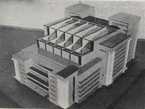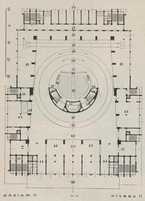choose space
theatre space
The design of the Symultaniczny Theatre was one of three by Pronaszko, all of them based on the modernistic idea of ‘the space unity theatre’, which definitively broke with the tradition of the single surface box stage in favour of the common space of actor and spectator, designed as two coaxial rings, moved around the whole interior. The modernity of such a solution consisted equally in the extremely avant-garde block of the building, made of concrete, steel and glass, breaking with the bombastic decorum of historicising 19th century theatres, in exciting technological novelties (common ‘tent’ space , covered with a vaulting whose curvature was counted according to the acoustic method of Gustave Lyon, the creator of the Pleyel Room in Paris; a revolving stage, electrically driven, electric lighting being a basic element of scenography), as well as in, generally, the whole conception of the theatre space. The interior of Syrkus and Pronaszko’s theatre definitively rejects the tradition of stage as a separated and framed space, based on the scheme of the central perspective. Since the frame/framing refers to the simplest way of perceiving the space, thus creating the image of the world, as described – in Lyotard’s terms[1] – i.e. concentrated distinctly in one place and leading the spectator inside the precisely marked (framed) space.[2] ‘Mathematical formulae of this kind serve to <alienate> the consolidating – ordering reality as a centralised, ordered and organised world around the centre – the stage.’ Rudolf Arnheim compared the central perspective, which forms the hierarchically and purposefully structured world, to a flow that is ‘orientated towards a specified end [...] transforming the timeless simultaneity [..] of undeformed space into a happening in time’; in this way ‘the world of being is redefined as a process of happening.’[3] The scheme of the theatre space was broken up, among other examples, in the Syrkus and Pronaszko’s design, where a central perspective was replaced by processualism and a communal perception of the performance.
Marta Leśniakowska
[1]‘Assessing a space in the meaning of framing it equals describing it.’ Jean François Lyotard, Lessons on the Analytic of the Sublime, translated by Elisabeth Rottenberg, Stanford University Press 1994, p. 154.
[2] Compare: Rudolf Arnheim, Art and Visual Perception: A Psychology of the Creative Eye. Polish edition: Sztuka i percepcja wzrokowa. Psychologia twórczego oka, translated by Jolanta Mach, Gdańsk 2004, p. 334.
[3] Ibid., p. 335.
Type of space: variable space




